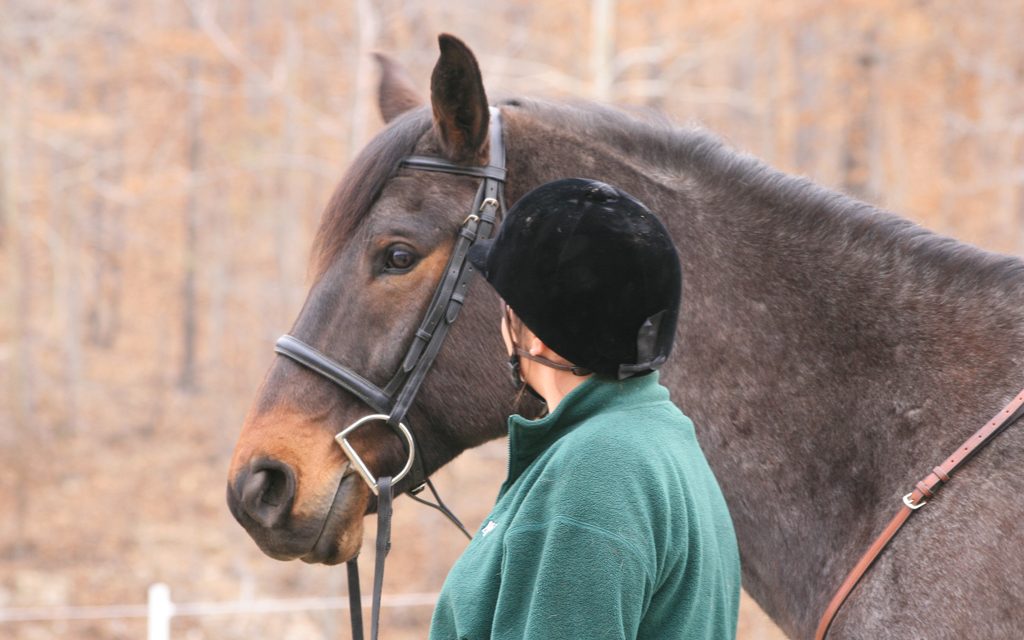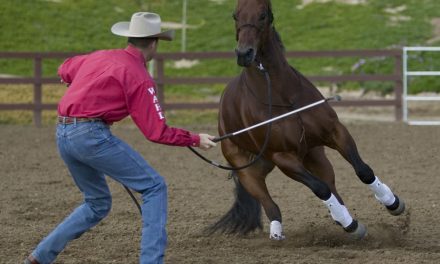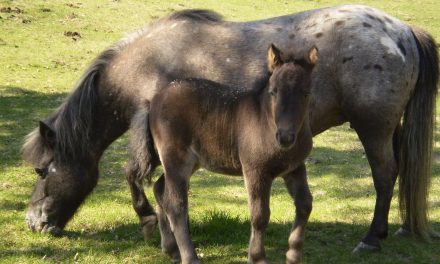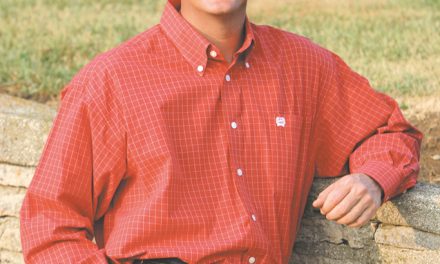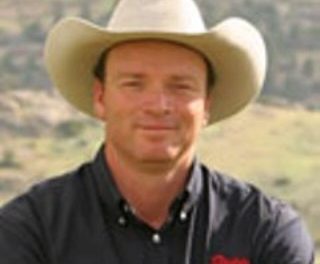
Horses are very attuned to body language, so we have to be aware of what our body language is saying to them.
Most of us are aware that humans are big, verbal communicators. However, not all of us are conscious of the role body language plays in our daily interactions. For example, if I’m in public and someone I don’t like comes up to me, I have to act civilized since I’m in public. My lips might say all the right things, but my body language has a certain attitude about it.
Unlike humans, horses communicate almost exclusively by body language. Of course, they nicker and whinny to each other, but they spend most of their time reading each other’s body signals. They lower their heads and pin their ears, cock their hind legs, raise their heads, and snort with flared nostrils.
One of the hardest things to teach people is how to effectively use body language when training horses. A lot of people struggle with using correct body language because they don’t understand how a horse thinks. That’s because horses and humans are two different types of animals.
Prey animals vs. predators
• Horses are prey animals. They constantly think that everything in the world is out to get them. That’s what has kept them alive for millions of years. A horse will investigate his environment first before walking up to an object. They will also either run from danger or fight predators to get away. If a horse can’t run away from a situation he finds threatening, his only other option is to fight.
• Human are predators. We’re direct- line thinkers; if we want something, we go and get it.
Since horses are prey animals and we’re predators, many problems arise between us.
Active and passive body language
Horses are highly-attuned to body language. That means we have to be aware of what our body language is saying to them.
There are two types of body language that humans can use with horses.
• Active body language. This type is assertive and lets the horse know that he needs to move his feet. When I want a horse to move his feet, I square my shoulders and look him directly in the eye. To exaggerate that I want the horse to move, I may lean forward towards him and have a more stern or cranky look on my face.
• Passive body language. When you want the horse to stand still and relax to whatever you’re desensitizing him to, use passive body language. If you want the horse to relax, don’t square your shoulders or look him directly in the eye. Instead, cock a leg and relax your shoulders. Since you don’t want the horse to move, your body should have an overall relaxed look to it.
While we have to be conscious of what our body language is saying to the horse, it’s the horse’s job to learn to read our body language correctly. In the beginning, you may have to exaggerate the difference between passive and active body language. But as soon as the horse learns your body language, you’ll be able to refine it. With my advanced horses, when I want to yield their hindquarters, I just have to look at their hips, and they disengage and move.
Be consistent and clear with your body language
My horses are able to respond well to my body language because I’m very consistent in their training. Consistency is your greatest ally, and inconsistency is your greatest enemy.
I always tell people to be black and white with no shades of gray. If the horse does the right thing, make him feel comfortable. If he does the wrong thing, make him feel uncomfortable. When I say shades of gray, I mean your body language is ineffective, and the horse is confused and not sure what to do. The more black and white you are, the easier it is for the horse to do the right thing.
The faster you can switch between being black and white and making the horse feel comfortable for the right behavior verses uncomfortable for the wrong behavior, the quicker the horse understands what you want.
When the horse does the wrong thing, the faster you can make him feel uncomfortable, the sooner he’ll understand not to do that behavior. The instant the horse tries to correct himself, it may not be perfect, but if he tries, make him feel comfortable and jump back to the other shade.
As a kid, do you remember goofing off in a public place and your mom would look over at you and give you that look — the “I’m going to kill you” look? She couldn’t kill you in public, but you knew she was going to kill you at home, and it was going to be one long car ride home. At other times though, when you were behaving in public, she’d smile or wink at you and you could tell she was proud of you.
That’s the type of relationship you need to have with your horse. The horse needs to read your body language and instantly respect it.
Most people want to constantly hang out at a shade of gray with their horse. As a result, their horse’s performance is inconsistent at best. They aren’t really sure what they are asking, so the horse doesn’t have a clue what he’s supposed to do. When you teach something to your horse, make sure you know what you’re doing first. Doyour homework before you go out to the barn and try it on the horse. If you don’t know what you’re doing, there isn’t a hope in the world that your horse will either.
For example, if a horse pins his ears back at you, and you don’t do anything about it, you might as well be holding a big sign up that says, “Bite me.” Even though the horse didn’t bite you, the fact that you didn’t do anything about it gives the horse the signal that it was OK.
On the other hand, if you backed the horse up and made him feel uncomfortable, it would have been clear that his behavior was unacceptable.
You don’t need to teach your horse anything; you just need to allow him to do it. So in turn, when you allow him to do something wrong, you’re really teaching him to do it.
When you back the horse up, or in some way make him feel uncomfortable, you have to do it with assertiveness. If you’re like, “Oh, please stop the grumpy face,” and let the horse drag his feet, it won’t work because you’re being ineffective like a nagging mother. There’s nothing in the world horses hate more than nagging mothers. The horse is like, “Man, I’d really love to bite her now because she’s really annoying me.”
Be black and white, and make it obvious what you want the horse to do. Don’t leave the horse wondering why you made him feel uncomfortable. Make it clear that he did something wrong and that his behavior isn’t acceptable. As soon as he corrects his bad behavior, instantly make him feel comfortable.
I don’t encourage people to use verbal cues because I’ve found that people who use their voice all of the time end up begging their horses to perform. The only verbal cues I use are “whoa” to tell him to stop and a clucking sound to tell him to move his feet faster.
It’s not that verbal cues don’t work; it’s that I find most people who use a lot of verbal cues to train their horses are very ineffective with their body language and they are constantly begging their horses to do things. Most people who use a lot of verbal cues have the poorest body language and the most disrespectful horses. Sure, not everybody who uses verbal cues has this outcome, but I would say a large percentage do.
It would be great if we could tell our horses exactly what we wanted them to do, and how we wanted them to do it, and they would just do it. Unfortunately, that’s not how it works. However, if you work on controlling your body language and understand the difference between active and passive body language, you can communicate with your horse on a productive level.
The results you see will literally be amazing.
Through his widely-popular Downunder Horsemanship program, Clinton Anderson works hard to educate horse owners on how to be safe and effective while enjoying their horses. His training methods are easy to understand and are designed to help horse owners get the results they desire. Clinton holds clinics and can be seen on RFD-TV. This Australian native is a two-time champion of the rigorous Road to the Horse Colt Starting Challenge, which gives trainers just three hours to break an unstarted colt. Learn more about Clinton at www.downunderhorsemanship.com.

